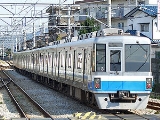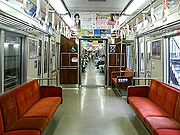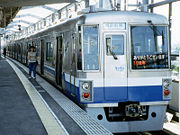
Fukuoka Subway 1000 series
Encyclopedia


Electric multiple unit
An electric multiple unit or EMU is a multiple unit train consisting of self-propelled carriages, using electricity as the motive power. An EMU requires no separate locomotive, as electric traction motors are incorporated within one or a number of the carriages...
operated by the Fukuoka City Transportation Bureau
Fukuoka City Subway
The serves Fukuoka, Japan. It consists of three subway lines, the Kūkō, or Airport Line, the Hakozaki Line and the Nanakuma Line).The lines are operated by the . Unlike most other public operators in Japan, the company only operates subways without any bus lines....
on the Hakozaki Line and Kūkō Line in Fukuoka
Fukuoka, Fukuoka
is the capital city of Fukuoka Prefecture and is situated on the northern shore of the island of Kyushu in Japan.Voted number 14 in a 2010 poll of the World's Most Livable Cities, Fukuoka is praised for its green spaces in a metropolitan setting. It is the most populous city in Kyushu, followed by...
, Japan. The trains also inter-run to/from the Chikuhi Line
Chikuhi Line
The is a railway line in Japan running from Meinohama Station in Fukuoka City, Fukuoka Prefecture to Karatsu Station in Karatsu City, Saga Prefecture, and from Yamamoto Station in Karatsu City, Saga Prefecture to Imari Station in Imari City, Saga Prefecture....
, operated by Kyushu Railway Company
Kyushu Railway Company
The , also referred to as , is one of the constituent companies of Japan Railways Group . It operates intercity rail services in Kyushu, Japan and the JR Kyushu Jet Ferry Beetle hydrofoil service across the Tsushima Strait between Fukuoka and Busan, South Korea.When Japan Railways was divided in...
(JR Kyushu).
History
The 1000 series entered service on the Fukuoka City SubwayFukuoka City Subway
The serves Fukuoka, Japan. It consists of three subway lines, the Kūkō, or Airport Line, the Hakozaki Line and the Nanakuma Line).The lines are operated by the . Unlike most other public operators in Japan, the company only operates subways without any bus lines....
coinciding with its opening on July 26, 1981.
In 1982 it received the 22nd "Laurel Award" which is granted by a committee for excellent design.
The first eight trains were manufactured by Kinki Sharyo
Kinki Sharyo
is an Osaka, Japan-based manufacturer of railroad vehicles. It is an affiliate company of Kintetsu Corporation.In business since 1920 and renamed The Kinki Sharyo Co., Ltd in 1945...
in 1981. To cope with operations on the Chikuhi Line, seven more trains were built by Kawasaki Heavy Industries
Kawasaki Heavy Industries
is an international corporation based in Japan. It has headquarters in both Chūō-ku, Kobe and Minato, Tokyo.The company is named after its founder Shōzō Kawasaki and has no connection with the city of Kawasaki, Kanagawa....
in 1982. Three more sets were built by Nippon Sharyo
Nippon Sharyo
, , formed in 1896, is a major rolling stock manufacturer based in Nagoya, Japan. In 1996, it abbreviated its name to "日本車両" Nippon Sharyō. Its shortest abbreviation is Nissha "日車". It was a listed company on Nikkei 225 until 2004. It is listed on the Tokyo Stock Exchange and Nagoya Stock Exchange...
(1984), Tokyu Car Corporation
Tokyu Car Corporation
is a manufacturer of heavy rail cars in Japan. The company is based in Kanazawa Ward, Yokohama, Japan, and a member of Tokyu Group. Tokyu Car manufactures rail vehicles not only for Tokyu Corporation but for other Japanese operators, including various Japan Railways Group companies and...
(1985), and Hitachi
Hitachi
Hitachi is a multinational corporation specializing in high-technology.Hitachi may also refer to:*Hitachi, Ibaraki, Japan*Hitachi province, former province of Japan*Prince Hitachi and Princess Hitachi, members of the Japanese imperial family...
(1986). The fleet consists of a total of 18 trainsets (108 cars).
Driver-only operation commenced on January 20, 1984 using automatic train control
Automatic Train Control
Automatic Train Control is a train protection system for railways, ensuring the safe and smooth operation of trains on ATC-enabled lines. Its main advantages include making possible the use of cab signalling instead of track-side signals and the use of smooth deceleration patterns in lieu of the...
(ATC), and the cabs are equipped with a master controller, brake handle, and automatic train stop
Automatic Train Stop
An automatic train stop is a system on a train that will automatically stop a train if certain situations happened to prevent accidents from happening....
(ATS) system for manual operation.
Design
Because the train line runs near the coast, car bodies were constructed of a stainless steel skin on a conventional steel frame for corrosion resistance. The car bodies are unpainted with blue and white stripes representing the Genkai SeaGenkai Sea
The is a body of water that comprises the southwestern tip of the Sea of Japan and borders the northern coasts of Fukuoka and Saga prefectures....
.
Each car is 20 m long with four pairs of doors per side. Early trainsets had opening windows, but these were subsequently replaced with sealed windows.
The trains have emergency exit doors at the ends. The doors and window wipers were added after refurbishment.
The longitudinal seats are covered with a red moquette
Moquette
Moquette is type of fabric with a thick, dense pile. It is a particularly versatile and hard-wearing material, predominantly wool with a small percentage of polyester. Moquette is renowned for its attractive, hard-wearing, durable, and fire-resistant qualities, hence it is commonly used for...
and some parts of the saloons feature woodgrain panelling. In 1982, wheelchair spaces were added to the cars. All trains are air-conditioned.
Refurbishment
Between 1997 and 2004, 15 years after the first trains were built and after the introduction of the 2000 seriesFukuoka Subway 2000 series
The is an electric multiple unit operated by Fukuoka City Transportation Bureau on the Hakozaki Line and Kūkō Line in Fukuoka, Japan.- History :The 2000 series was introduced in 1992 ahead of the opening of the Line between Fukuoka Airport and Hakata Station on March 3, 1993...
, the trains underwent refurbishment. After refurbishment, the trains were called 1000N series. Refurbishment included the following major modifications.
- Variable-frequency drive added
- Cab end window changed (now similar to 2000 series)
- Large windows changed
- Rollsign destination indicators replaced with LEDLEdLEd is a TeX/LaTeX editing software working under Microsoft Windows. It is a freeware product....
indicators - Interior veneer panelling and floors changed
- Electronic displays showing next station, door chimes and wheelchair spaces
In 2000, Hitachi manufactured a three-level Insulated-gate bipolar transistor (IGBT) traction inverter for the trains, and in 2001 it was changed into a full-electric brake with a two-level IGBT.

